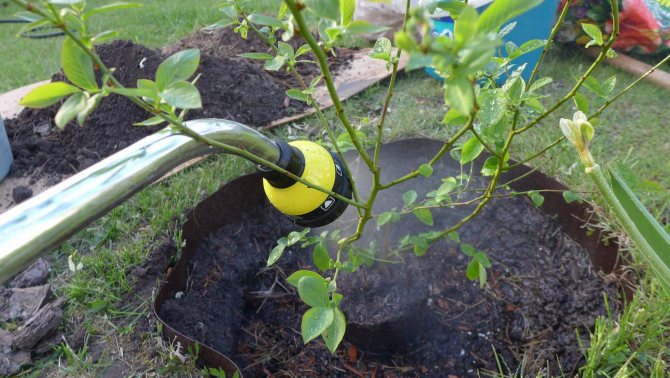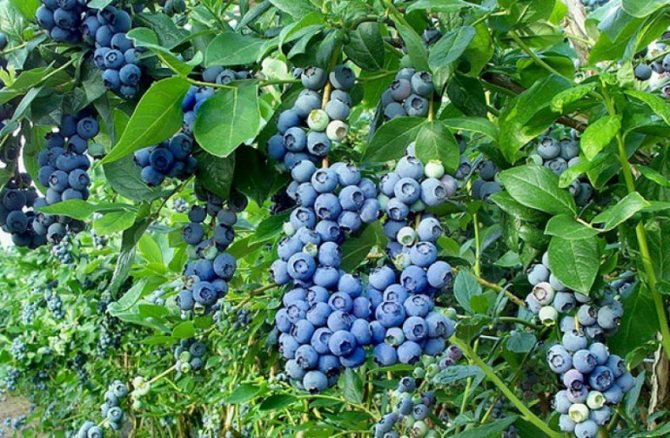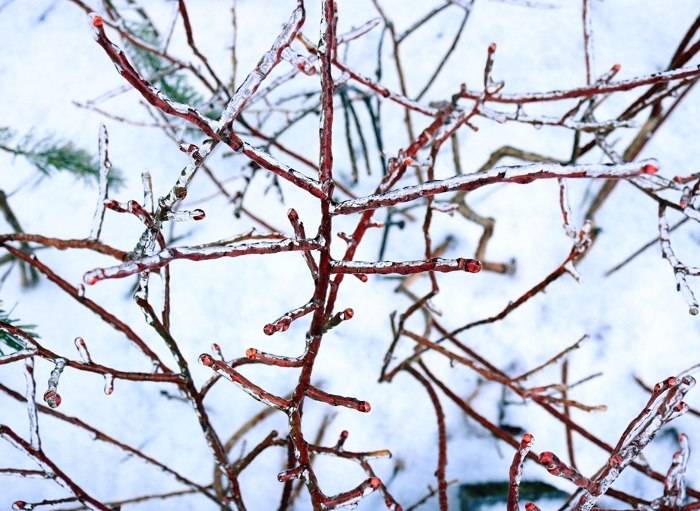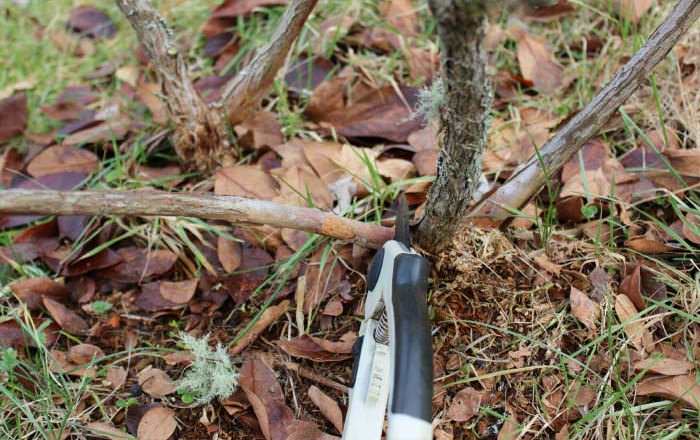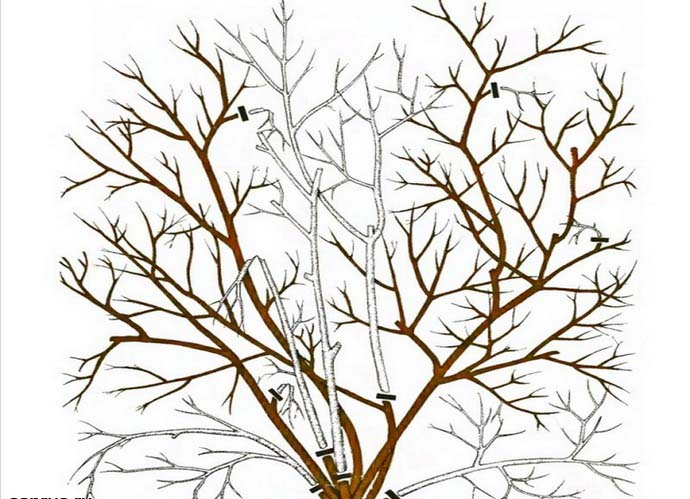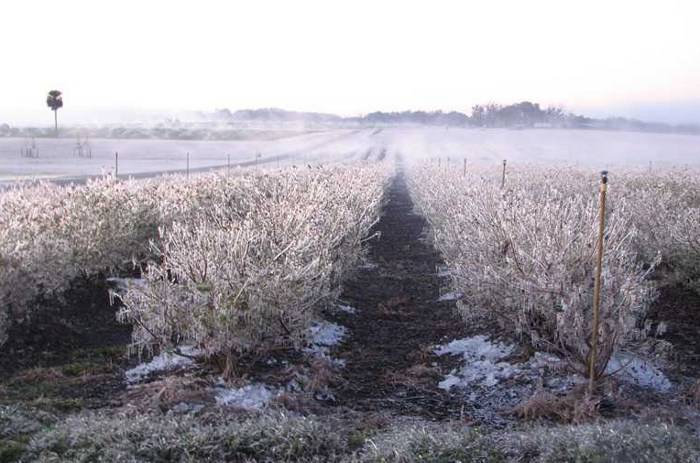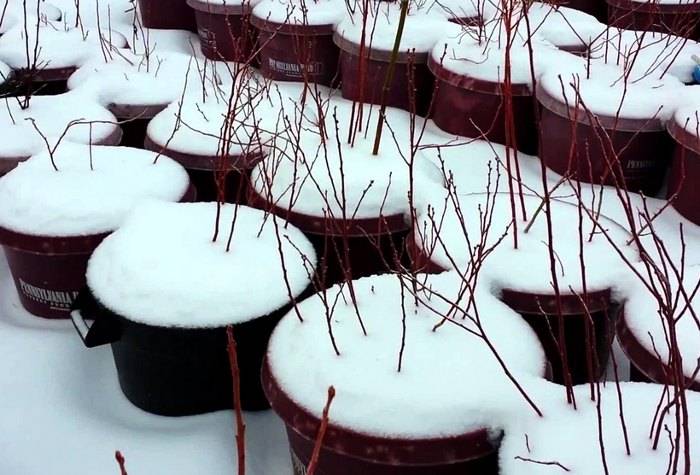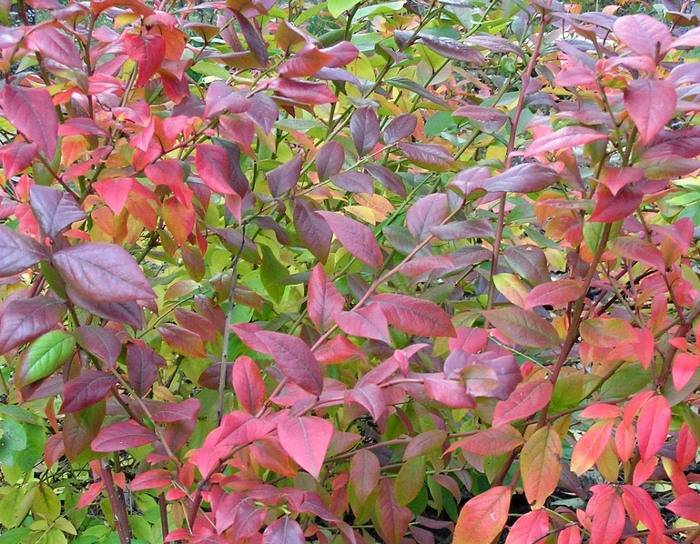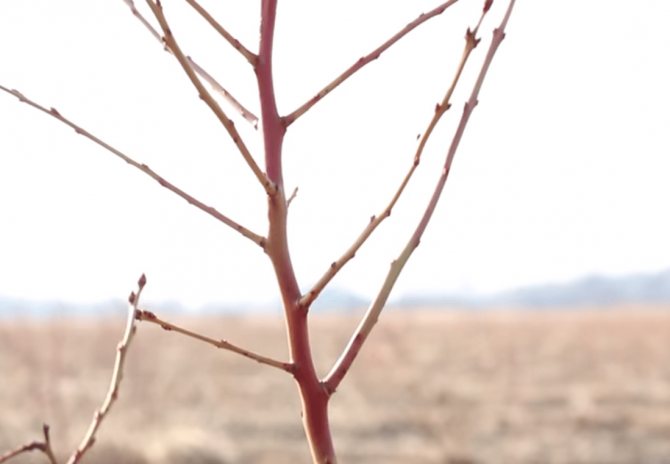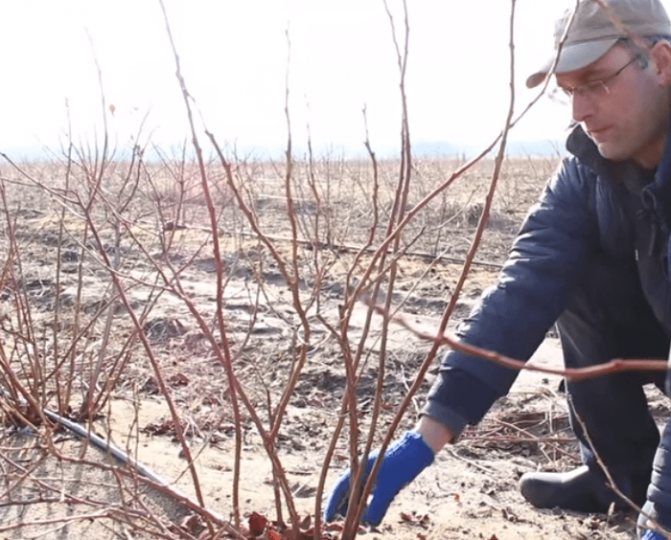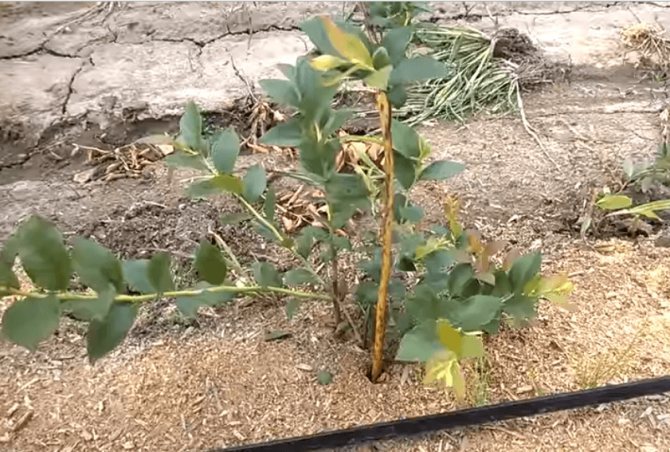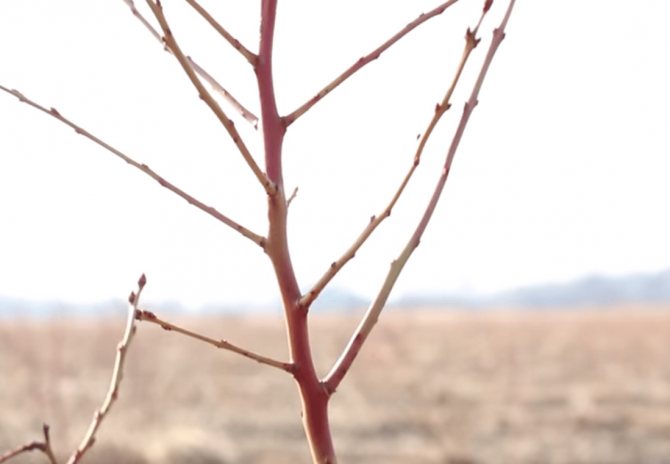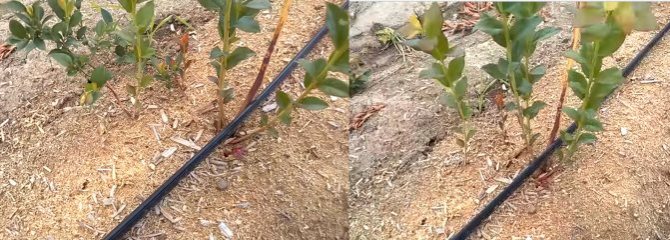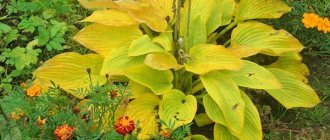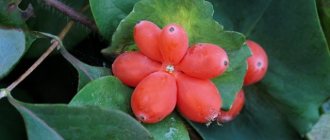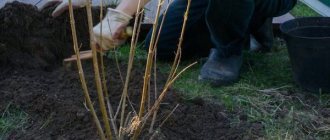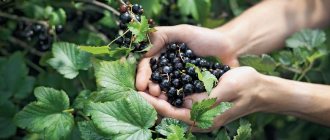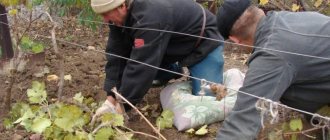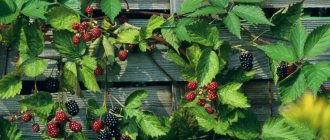Features of blueberry care
Caring for blueberries in autumn involves a number of activities: loosening the soil and watering, pruning bushes, mulching, fertilizing with mineral additives, monitoring the condition of the soil.
Watering. In July-August, even before the onset of autumn, it is necessary to water the blueberry bushes abundantly. At this time, the plant produces fruit buds for the next year. In the fall, watering is completely excluded or reduced to a minimum. But this must be done if the plant is able to feed on rain.
Mulching. Another important step in blueberry care. The mulch material must be changed in the fall every year. Mulch is designed to retain moisture in the soil at the roots of the plant, preventing evaporation. It is better to use spruce branches, coniferous bark, sawdust.
Fertilizing the soil. Fertilizing of berries is carried out according to the scheme of applying mineral fertilizers. The use of organic fertilizers is prohibited. Fertilizers are applied twice in the summer and once more in the fall. The amount of fertilizers is 40 grams of potassium and superphosphate. If blueberries lack nutrients, the plant begins to dry out, the leaves wither and fall off.
Pruning. Sanitary pruning of blueberries is carried out in autumn. It has the function of removing broken and dried shoots and other parts of the blueberry bush, which have harmful parasites.
Soil acidification. Blueberries do not grow in alkaline or neutral soils. At the end of August, the soil must be fertilized with a 9% solution of acetic acid, dissolved in a ratio of 60 g / 10 liters of water.
Warming for the winter. Tall blueberry bushes are not afraid of frost, if the bushes are small, you need to install supports, pull the rods through the bush and tie branches to them. From above, the bushes are covered with oilcloth or spruce branches.
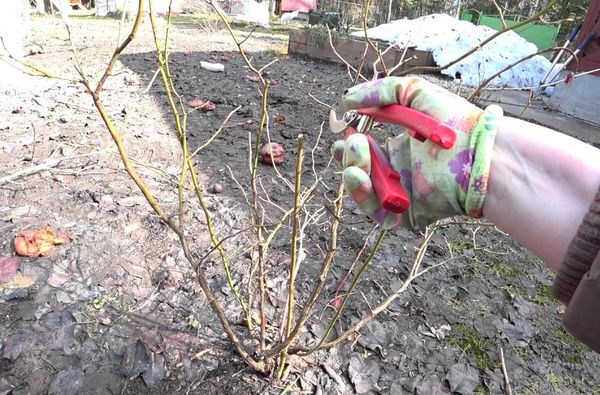
Autumn feeding
Having removed all unnecessary shoots, the places of the cuts on the shrub are treated with garden varnish or the "RunNet" product. This measure will protect the plant from insect penetration into the tissues and infection. After that, the blueberries are well watered and fertilized. In autumn, mineral complexes enriched with phosphorus and potassium are used. Nitrogen fertilizing is not used so as not to provoke the growth of the green part.
Fertilize blueberries from the age of two. For young specimens, they take less feeding than for overgrown, large plants. In July, urea or ammonium sulfate is added, so that mineral complexes do not fall on the leaves. It is convenient to dilute the granules in water in an amount of 40 g per bucket of water and pour this solution over the soil, retreating 15 cm onto the bush.
To increase resistance to diseases and reduce the likelihood of pest attacks in the fall, fertilizers with potassium and phosphorus are applied. Such dressing makes the berries taste much better. For each adult plant, 40 g of potassium and superphosphate are used.
Half a month before harvesting, the shrub is sprayed with the "Crystalon" preparation. This fertilizer is a mixture of useful minerals, does not contain chlorine. It is safe for all types of berries, vegetables and fruit crops. The drug in an amount of 20 g is dissolved in a bucket of water and sprayed on the shrub during hours when there is no active sun. It enhances growth, increases pest resistance and improves crop quality.
How is autumn pruning carried out
It is imperative to remove some of the branches in the fall, otherwise the blueberries will quickly degenerate into the wild. You need to cut off all infected, old, dried, broken branches. If you ignore the fall pruning, there may be too many young growth. The shoots will be weak and small, since it is impossible to develop in a thickened crown. The bushes are trying to give all the nutrients to the young shoots, the fruits are left without food. The berries become sour, their taste deteriorates.
The dense crown is a breeding ground for parasites and pathogenic bacteria, they begin to spoil the culture. Partial pruning isn't just done in the fall. It is better to remove excess shoots all year round. In the spring, the frozen ends of the shoots are removed, in the summer, the branches that thicken the blueberry bushes are removed. Closer to autumn, sanitization is carried out.
Formative pruning of young and old plants
Formative pruning of bushes is necessary in late autumn, when sap flow has completely stopped. This is usually done from mid-October. Extra branches are removed, and the cuts are covered with garden var. This is necessary to prevent bacteria from entering the plant, which can cause infection. Pruning later than November is not worth it, otherwise the plant may suffer from frost.
Some gardeners, when planting blueberries, do not prune them for one or two fruit seasons. It is mistakenly believed that young shoots that grow during this period will be able to bear fruit in two years. But root shoots are released, buds are formed at their tops, to which the plant directs all its nutrients. Pruning should not be neglected if you want to grow a good fruit-bearing tree.
If the seedling is planted in the spring, formative pruning is carried out in the fall to remove all growths at the base of the plant, diseased branches. It is necessary that an even column with a height of 30 cm remains without branches. When pruning an adult plant, only extra shoots are removed:
- horizontal to the strongest vertical branch;
- shoots of the third and second order, growing downward and inward;
- the upper parts of the shoots infected with pests, damaged by frost;
- all shoots are less than 30 cm.
Anti-aging pruning
Rejuvenating pruning is only necessary for older plants. It is necessary to remove old branches, otherwise they thicken the plant, drawing out all the nutrients. The next year, the young will give a good growth and give a rich harvest of appetizing and juicy berries.


Features of the berry
The blueberry is a bush with oval green leaves, reaching a height of one to two and a half meters. The berries are blue, 1-2 centimeters in diameter.
The blueberry bush contains shoots of different ages. The branches on the sides over two years old are distinguished by the highest yield. Old branches that are more than four to five years old bear much less fruit than two to three years old.
Young stems have a smooth bark of bright color, there are no branches on them. Older stems are characterized by strong branching and yield the richest yields. In order to achieve a rich harvest in plantation conditions, it is customary to leave a dozen fruiting branches on the bushes.
Shelter blueberries for the winter
Shelter for blueberries is essential to protect the plant from frost. The plant tolerates frost very well, however, if the temperature drops below 25 degrees, the shrub may freeze out. The percentage of plant death increases if the winter is too frosty and there is little snow. So that the plant does not suffer, it needs to be insulated.
How to shelter blueberries for the winter? Warming for the winter is carried out in several stages:
- Until the time when it gets very cold, the branches are carefully bent to the ground, after straightening them. The branches are pulled with twine.You can install special arcs that will hold the branches, preventing them from unbending.
- As soon as frost sets in, the bushes are covered with agrofibre or burlap. You should not use the film, under it the branches can rot, which contributes to the appearance of the fungus.
- After the snow falls on the plant, you need to throw a layer of snow on top. Then frosts will not be able to penetrate into the burlap. The bush will be reliably insulated.
- With the onset of spring, it is necessary to remove the covering material. Remove those tips of young shoots that are frozen. Minor spring frosts will not harm the buds and flowers. Plants can withstand temperatures as low as -8 degrees. The shelter of the garden blueberry will preserve the plant. Fruiting buds will not freeze, which guarantees a rich harvest.
Read also Recipe for harvesting horseradish for the winter without sterilization
Mulching
The mulch needs to be changed annually, in the fall, after you've fertilized the soil and oxidized it. The most important thing is to be in time before the frost. The bark of trees, sawdust, needles, straw or dry earth are suitable as a basis.
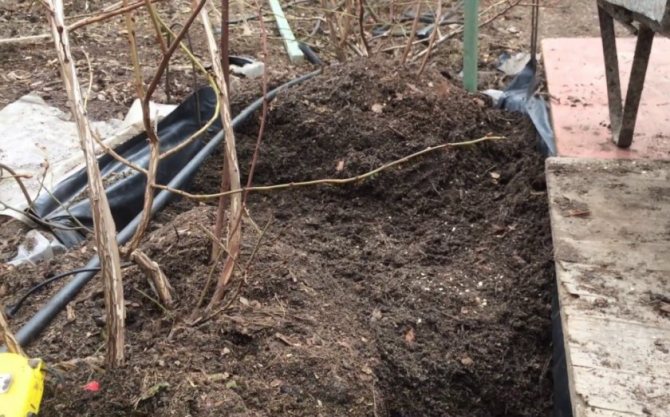

The layer of the mulch itself can range from 4 to 15 cm. Such a precaution will help reduce the number of weeds on the site and protect the bush from the negative effects of spring frosts.
Read also Pancakes with milk, soda slaked with vinegar
Preparing for winter in different areas
Growing blueberries somewhere in Siberia is significantly different from growing this crop in the Moscow region.
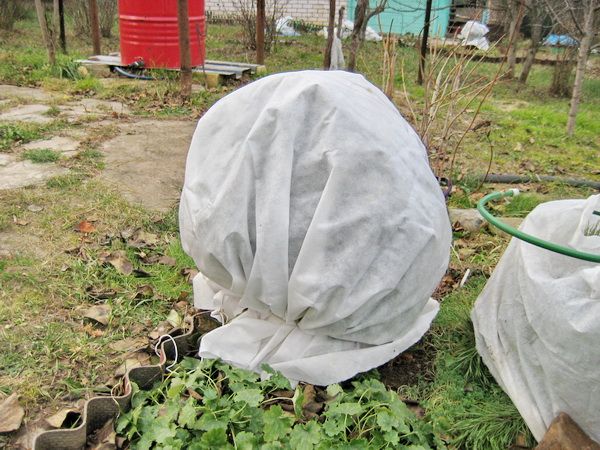

Preparation of blueberries in the suburbs
Blueberries are ideal for growing in the Moscow region. The conditions are right there for her. But in winter you need to cover the plant, winters are sometimes quite harsh. The shrub must be wrapped in burlap according to the above method. You can use pine spruce branches rather than burlap. First, the shoots are bent to the ground, then they are thrown with spruce branches in a large volume.
Preparing for winter in Siberia, the Volga region and the Urals
To grow blueberries in the Urals and Siberia, you need to select varieties that were bred specifically for these regions. Such varieties grow to a height of no more than 80 centimeters. The brightest representatives of the bog blueberry are the following varieties: Divnaya, Canadian nectar, Taiga beauty.
The preparatory steps for caring for blueberries in the fall are no different from caring for other plants. There is no additional need to shelter blueberries in the Urals and Siberia, there is enough snow in these areas, which will be the best shelter. In spring, blueberries can bloom in full force.
The Volga region is not the best area for growing blueberries. Residents of this region prefer to buy purchased blueberries rather than grow them.
Gardeners' mistakes in blueberry care
Blueberries are not a rare plant. In many garden plots, this berry is grown by gardeners from year to year. But budding gardeners often make mistakes. Consider what situations should be avoided during the autumn preparation of blueberries for wintering:
- Bringing the soil to the state of a swamp due to excessive soil moisture. This causes a lack of oxygen for the roots. During winter frosts, it causes freezing of the root system, which can destroy the entire bush.
- Excessive acidification of the soil. Blueberries need acidic soil, so acetic acid is added to the soil. But if the acid reaches an indicator of more than 5.5, the mycorrhiza fungus, which is very important for the plant, dies in it. It is needed for the quality assimilation of nutrients by the plant.
- Excessive crowding of branches and shading. Blueberry bushes love open, sunny areas. Blueberries can withstand the shade from other plants, but when the branches are crowded, the plant produces fewer berries, the leaves begin to fall off.
- Lack of fertilizer. Blueberries can stay for a long time without fertilizers.If you do not apply top dressing for more than five years, the plant is depleted, this affects the external state of the tree, on the fruits.
The blueberry season is over and you are harvesting your last harvest. What to do next? Obviously, it is required to somehow prepare the berry bush for winter.
Next, we will look at the main activities that are recommended during the autumn blueberry care.
Correction of soil acidity
Garden blueberry is an acidophilic plant that is unable to absorb nutrients at low acidity. The alkaline environment makes vital trace elements inaccessible to garden blueberries: iron, boron, zinc, manganese, phosphorus. They turn into insoluble hydroxides. The plant is starving, no matter how much fertilizer is applied under it. If your area is neutral or alkaline, then the place for blueberries should be acidified.
What contributes to soil acidification:
- applying mulch under the bush, consisting of pine sawdust, peat, needles or bark of coniferous trees;
- periodic watering with acidified water (add 100 ml of 9% vinegar to a bucket of water).
Coniferous mulch not only creates a favorable environment for the absorption of food by blueberries, but also serves as an obstacle to moisture evaporation, prevents excessive soil compaction, eliminates the need for frequent loosening, and prevents weed growth.
Note! In most of the territory of Russia, the soil gives a slightly acidic reaction, which is sufficient for growing garden blueberries without additional acidification.
You can find out what kind of soil on your site using a special litmus indicator or by growing weeds - field horsetail always begins to grow on acidic soil. If the soil on your site is alkaline, then planting garden blueberries is carried out in a limited amount of acid forest peat, as shown in the figure below.
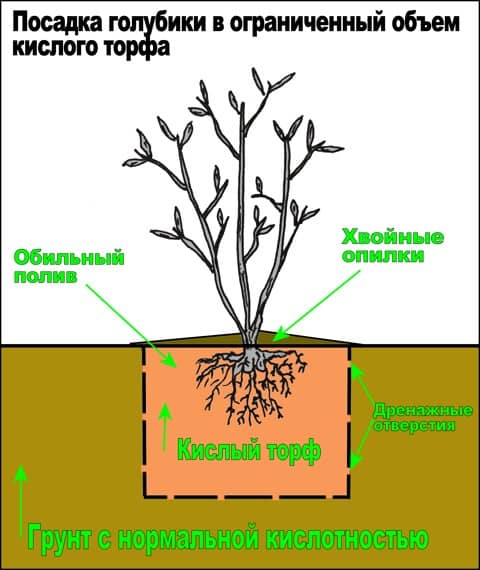

What to do with blueberries in the fall: basic winter preparations
So, here's what you should do with your blueberries in the fall to get them ready for winter properly:
- Feed immediately after the end of fruiting and harvesting.
- Conduct sanitary pruning.
- Can be transplanted (if necessary, it is best to do this
Advice! It is better to replant blueberries in autumn when the leaves have already begun to crumble or at least turn red.
- Monitor humidity, i.e. continue to water (remember that blueberries belong to heather crops, which are very demanding on watering) and carry out moisture-charging watering (if the autumn is rainy enough, then it is not necessary, if it is dry, then it is very desirable - the earthen lump must be soaked to a depth of 15-30 cm) ...
- Shelter for the winter (mulch).
Video: how to care for blueberries in autumn and properly prepare for winter
When and how to feed blueberries in autumn
The purpose of the autumn feeding is to help the shrub to lay new flower buds for the next year, as well as prepare the plant for winter (strengthen its immunity and improve winter hardiness).
When to fertilize
The last (autumn) feeding of blueberries is done after fruiting and picking berries, i.e. in the fall.


What to feed
Remember that the end of fruiting and the onset of autumn (i.e. August-September) is the period when phosphorus-potassium fertilizers must be applied under all perennial plants (including blueberries).
So, phosphorus is necessary in order for the plant to strengthen the root system, and potassium for better ripening of the shoots, so that the branches do not freeze in winter, as well as for better laying of fruit buds for the next year. In short, the autumn feeding of blueberries is required for a good wintering and a rich future harvest.
It is especially desirable to feed if at the end of summer the growth of young shoots becomes noticeable.
What fertilizers are suitable (apply according to the instructions on the package):
Naturally, it is much more effective to use quickly and easily dissolving fertilizers, while the same superphosphate dissolves very poorly and does not act immediately.
- potassium sulfate (potassium sulfate) + superphosphate (slow);
- diammofoska (slow);
- potassium monophosphate (fast);
- plantafol or plantafid (fast).
Note! Blueberries are a "acid-loving" plant, which means that in alkaline soil it will very poorly assimilate any food.
So by no means do not feed blueberries with wood ash (use as potash fertilizer).
How to apply top dressing:
- Better at the root (root top dressing), but you can also on the leaf (foliar top dressing).
Advice! Top dressing in any case should be liquid: pour dry fertilizer and wait for the weather from the sea, i.e. rain is not the best idea.
Video: how to fertilize blueberries in the fall
Do I need to acidify the soil in the fall
As a rule, acidification of the soil under blueberries is done in spring and summer, but not in autumn.
By the way! The site has a separate material about how and what can acidify the soil under blueberries.
Pruning blueberries in autumn
Let's say right away that main trim blueberry it is better spend in the spring... The fact is that you never know what winter will be like and how your berry bush will survive it.
Read also How to use nutmeg
Another thing - autumn sanitary pruning of blueberries (with the beginning or after the fall of leaves), when necessary to get rid of broken, dry and painful twigs... Also subject to removal unripe young shoots.
Worth knowing! In general, rejuvenating and regulating pruning is required for blueberries.
If you do not prune in the future, then the bush will thicken over time, and the blueberries are simply crushed and become sour.
The best time to prune blueberries is early spring, before the buds swell.
Shelter blueberries for the winter
Blueberries are quite frost-resistant and can easily withstand frosts down to -34 degrees (but there are some thermophilic varieties that can withstand a maximum of -24 degrees), especially if the winter is snowy (Remember that snow is the best insulation!).
But, if your winters are usually frosty, but snowless, then the blueberries should definitely be insulated.
It is especially important to do this with young seedlings planted this year.
In general, the direct preparation of blueberries for winter consists in its shelter, or rather, in warming by mulching the trunk circle.
Video: the last preparation of blueberries for winter - mulching
Important! It is not necessary to wrap with agrofibre (spunbond, lutrasil), it is better to just mulch well and tie up the shoots so that they do not break off due to snow and winds.
As a maximum, young blueberry bushes (up to 2 years old) can be covered with spruce branches, putting it in a hut and tying it up. Thus, the snow will linger better on the bush, and it will be warmer in winter.
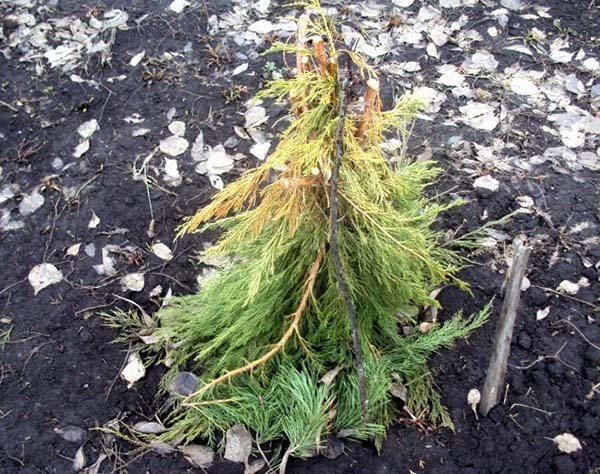

How can you mulch blueberries for the winter?
- dry sawdust:
- spruce or pine litter from the forest (preferably rotted);
- straw.
At what height to mulch:
- 5-10 centimeters (young, 1-2 years old, 8-10 s higher, older, 4-5 years old, - 5 cm).


Many people ask quite a logical question: “What to do with mulch in spring, namely sawdust?»
As a rule, it is better to lightly rake the sawdust on the sides and add some coniferous litter or sour peat in them, which do not harden and pass moisture well, in other words, loosen.
Thus, now you know what to do with blueberries in the fall, so that next season it will please you again (or for the first time) with a generous harvest. Good luck!
Video: preparing blueberries for winter
Small dark purple garden blueberries are good for vitamin C and are rich in natural vitamins and antioxidants. Growing blueberries in a garden or summer cottage has features associated with the characteristic features of the culture.Caring for blueberries in the fall is important for continued growth and a stable harvest.
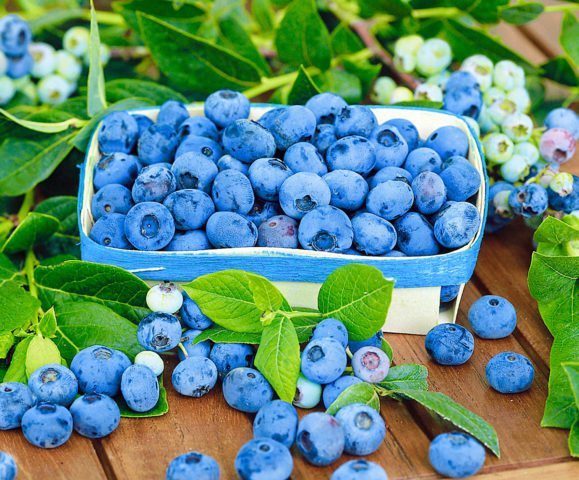

Frost-resistant blueberry varieties
Blueberries are widely used as an attractive ornamental plant, and a berry shrub, which gives a high-quality and tasty, as well as rich in vitamins and a high yield. For planting on a personal plot, it is advisable to give preference to the most unpretentious and frost-resistant varieties:
- "Bluegold" - an early ripe variety, ripening in mid-July, with a bush height within 120-150 cm and a yield of 4.5-7.0 kg;
- mid-season American variety "Blukrop" - ripens in July or August, differs in bush height in the range of 160-190 cm and a yield of 6.0-9.0 kg;
- high-yielding variety "Blue Ray" - ripens at the end of July, characterized by a bush height within 120-180 cm and a yield of 5.0-8.0 kg;
- grade "Bonus" - ripening in late July or early August, characterized by a bush height within 150-160 cm and a yield of 5.0-8.0 kg;
- grade "Herbert" - ripens in mid-August, characterized by a bush height within 180-220 cm and a yield of 5.0-9.0 kg;
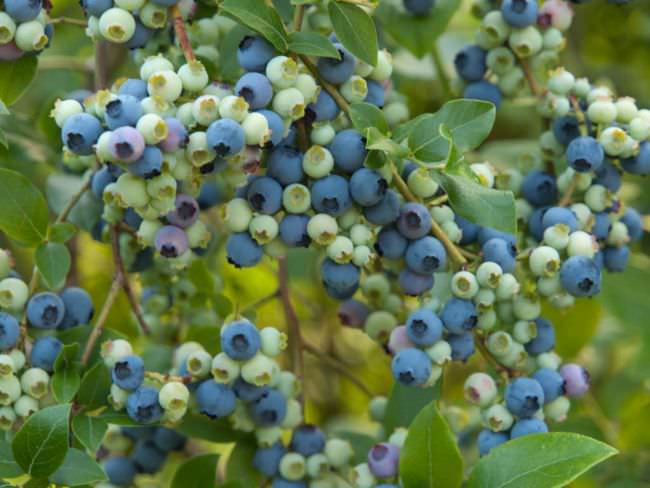

Blueberries are widely used as an attractive ornamental plant.
- tall variety "Jersey" - ripens in mid-August, characterized by a bush height within 160-200 cm and a yield of 4.0-6.0 kg;
- American variety Duke - ripens in mid-July, characterized by a bush height within 120-180 cm and a yield of 6.0-8.0 kg;
- grade "Northland" - ripens in the last decade of July, characterized by the height of the bushes within 100-120 cm and the yield of 4.0-8.0 kg;
- grade "Patriot" - ripens in mid-July, characterized by a height of bushes within 120-180 cm and a yield of 4.5-7.0 kg.
A very popular variety occupies a leading position in taste and aroma of the harvested crop. "Elizabeth", which forms bushes up to 180 cm high and is characterized by a prolonged fruiting period.
When to plant garden blueberries: spring or fall
Wild blueberry bushes grow mainly in areas where the temperate cold climate prevails. In garden plots, it is grown as single shrubs or whole plantations, if the size allows. With proper planting and observance of the rules of care, the bushes begin to bear fruit stably in the 2nd - 3rd year of existence.
The timing of planting blueberry seedlings depends on the characteristic features of the shrub culture. The trunk of the tree stretches up to 1.2 m, the fibrous root system does not have hairs that help trees and shrubs get nutrition from the soil, so the formation of the aboveground part of the plant is slow.
In order for the bush to take root and take root, garden blueberries can be planted on the site in the fall or spring. The time for planting is chosen taking into account that the tree adapts before the onset of frost. In spring, blueberries are planted only before buds swell on the branches. Many gardeners believe that planting garden blueberries in autumn is preferable to spring because they do not have to take care of the bushes during the spring-summer period, when insects are common on the site, which interfere with the adaptation of bushes and contribute to the transfer of diseases.
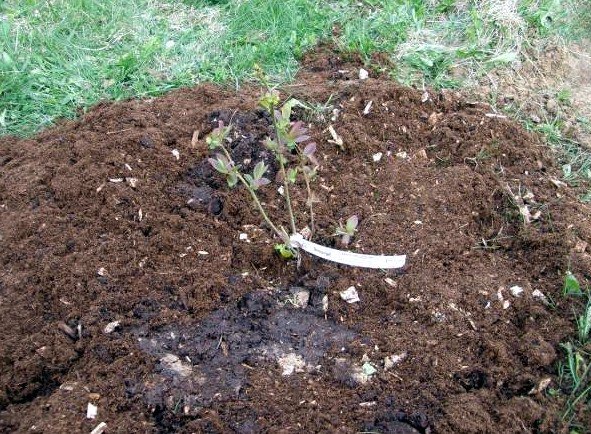

Fungal diseases
They are found everywhere, especially often, infection occurs against the background of hot and humid weather. The causative agent can be in the ground for a long time, tolerates severe frosts. Leads to massive damage to the bush, against which the yield is significantly reduced. Fungal infections respond well to early treatment.
Anthracnose
The causative agent of the disease is a fungus of the genus Botrytis cinerea. Infection usually occurs against the background of excessive planting density, stagnation of water in the ground and prolonged drought.Young bushes and plants are especially susceptible to the disease during flowering and fruiting. Infestation can be determined by the appearance of dark spots on the leaf blades. They gradually increase in size and dry out. Blueberries are lagging behind in growth, flowers are not tied, and the fruits fall off.
Read also Bacterial culture from throat
For the treatment of anthracnose on varietal garden blueberries, treatment with copper-containing fungicides is used as a Bordeaux liquid. In the early stages of lesion, complex drugs are effective, for example, Topsin M, Skor, Euparen and others.
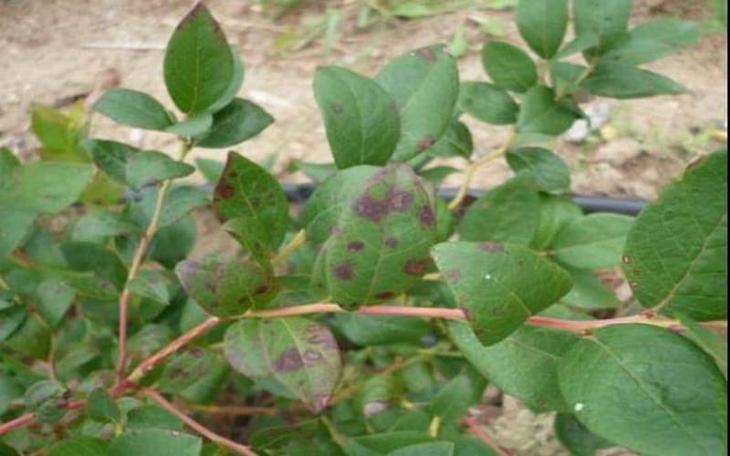

Gray rot
A common fungal disease that occurs in almost all climates. The pathogen is activated at high air and soil humidity, at a stable warm temperature. Leaves and stems are affected first. Yellowish spots appear on them, which gradually darken and affect a large area of the plant. The berries rot, and the bush itself withers and looks weakened. Even if there is no gray coating on the fruits, they cannot be used for food, as the taste and aroma change. All infected shoots die off within one season. Gray rot quickly spreads over the site, can overwinter on fallen leaves and in the soil.
The main method of treatment is spraying the planting with fungicides with a high copper content. For prevention, work is carried out in autumn and spring. In addition, it is important to remove all fallen leaves, the remains of other plants.
Phomopsis wilt
The disease is caused by a fungus of the genus Phomopsis vaccinii. Most often found on tall varieties of dove. Infection develops through the upper parts of the bush, then the entire stem, flowers and fruits are gradually affected. Symptoms:
- brown spots appear on the shoots, which merge and form brown-gray ulcers with a distinct border along the edge;
- after 2-3 months, active drying of the branches begins;
- the tops of the shoots are wrapped.
Outwardly, Phomopsis wilting resembles a sunburn, but the disease is extremely contagious for neighboring bushes. Treatment should begin with mass pruning of the affected parts of the bush. After that, the plant must be treated with a solution of Fundazol or Topsin.
Moniliosis, or fruit rot
A fungal disease that usually develops after a cold and snowy winter. The pathogen can tolerate low temperatures, it can stay in the ground for several years, retaining its potential activity. The first sign of moniliosis is a yellowing of the top of the stem. Flowers do not form or wither. If fruits have already formed on the plant, they darken and become wrinkled.
The infected plant should be pruned, leaving a few young and healthy shoots from the first year of growth. Then carry out a two-stage treatment of the planting with any copper-containing fungicide.
Stem cancer
The fungus enters the plant through the root system or the bottom of the bush. The peak of infection occurs in the first half of summer; young and weakened plants are at risk. Infection symptoms:
- the formation of red spots on the leaves in the form of dots, which gradually grow;
- deep ulcers develop on shoots and leaf blades, leading to death;
- the flowers become smaller, the fruits dry up and crumble;
- the plant gradually reduces the growth rate, stops developing due to metabolic disorders.
Stem cancer in garden blueberries is difficult to treat. The problem can be completely eliminated only in the early stages of infection. To combat the fungus, the bush and soil are treated with a 1% solution of Bordeaux liquid or Fundazole.
How to plant blueberries in the fall
Planting blueberries in the fall is associated with the subsequent pre-winter preparation. This means that it is necessary to correctly calculate the period so that there is enough time for preparation and adaptation.In the fall, blueberry seedlings are planted, which are grown from an adult bush during the winter, or seedlings that are in flowerpots.
Recommended timing
For planting garden blueberries in the fall, warm days are chosen throughout the second half of September - the first half of October. The timing depends on the climatic characteristics of the region. Before the onset of subzero temperatures, there should be about 30 days. This period will be enough for the rooting and adaptation of the culture.
Site selection and soil preparation
Blueberries grow in garden plots where the bushes get enough sunlight. In addition, when choosing a site, the following rules are observed:
- exclude places with through winds;
- choose flat territories;
- avoid places with a high occurrence of groundwater so that the root system of the plant is not constantly moistened;
- take into account that there are no plantings of tall fruit and berry trees next to blueberries, which can shade berry bushes with their crowns.
Acidic soils are suitable for planting blueberries. Soil acidity indicators should be within the range from 3.5 to 4.5 ph. Loose and light soils are suitable for blueberries, this makes it possible for moisture to be absorbed faster and contributes to the active development of a fibrous root system.
The preparation of the soil for blueberries depends on the original composition.
Light loam with groundwater deposition at a depth of about 2 m
They dig planting holes 60 cm wide and 40 cm deep.
Heavy clay soil
A 10-centimeter hole is dug, covered with sand, peat and sawdust, the seedling is planted on the formed mound so that the root system is buried at the ground level. The bush is mulched with a high layer of sawdust.
A hole is dug 1 m wide, 50 cm deep, covered with a layer of a nutritious acidic mixture (peat, sawdust, needles, sand), then a seedling is placed, covered with the remaining soil.
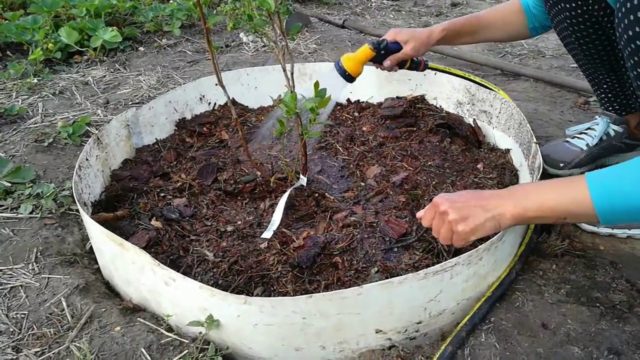

To increase the acidity of the soil in any area, acidification methods are used independently. For this, additives of dry powder of sulfur or a solution of oxalic or citric acids are used.
Read also How to cut a chicken into pieces correctly
Selection and preparation of seedlings
Planting material for planting in the fall is purchased in specialized nurseries. The best option is considered to be 2 - 3-year-old bushes. At the same time, berry varieties are chosen that take into account the characteristics of the climatic zone. For Siberia and the Urals, varieties are chosen that are able to withstand low temperatures. The branches of the seedlings must be strong and healthy, free from damage and stains.
Container seedlings cover the roots from inspection, so they are specially prepared when planting. The container is spilled a few hours before planting, then a clod of earth is carefully pulled out. The root system of blueberries during development can bend inward due to the flexibility of the roots. When planting, the roots are straightened so that they are directed downward and freely located along the planting hole.
How to properly plant blueberries in the fall
Planting blueberries in autumn is followed by special care related to the season, as well as preparation for winter. The speed of adaptation depends on whether the landing was done correctly.
For a medium-sized seedling, dig a hole 50 by 50 cm in size.On garden lands that are subject to active acidification, a special planting method is chosen using a 200-liter plastic barrel. It is laid at the bottom of the planting pit, covered with a layer of drainage. It can take from 10 to 20 cm. Then a small layer of the nutrient mixture is poured.
The seedling is placed in the center of the planting hole, filled with prepared nutrient mixture and tamped. About 1.5 m is left between the bushes, the roots most often grow in breadth, so they need a lot of space. The distance between the rows is extended to 2 m.
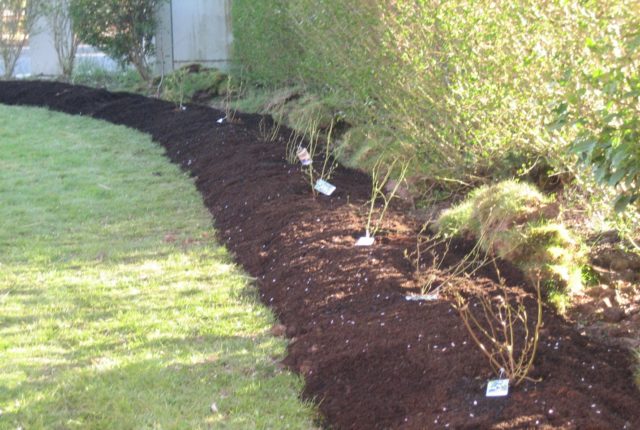

After watering the bushes, the berries are recommended to mulch the soil around.For mulch, acidic materials are chosen: sour peat, coniferous bark, rotted coniferous sawdust. Mulch protects the soil from freezing, moisture loss and prevents weeds from spreading.
Landing rules
When choosing plants, you need to take into account the compliance of the variety with the agro-climatic conditions of the region. Selecting a site and preparing the soil is easy enough, but with just one blueberry variety, it is difficult to create the conditions for good quality cross-pollination. At least 2-3 plants of various varieties should be planted side by side. Bushes located nearby will lead to better fruiting and early ripening of the crop. It should be borne in mind that without insect pollination, blueberry fruits are smaller and have a thick skin. It is advisable to cultivate honey plants near the berry, which attract insects well.


Landing time
Varietal seedlings of fruit shrubs are always sold in plastic boxes or pots. This is the most comfortable planting material. Plants can be grown at home until the planting site is prepared. When planting blueberries is important to achieve good results. You can transplant a seedling to a permanent place throughout the growing season. Planting a closed-rooted garden blueberry is similar to transferring a potted plant from a smaller container to a larger container. A lump of substrate protects the roots from damage, which allows a 2-3 year old seedling to quickly adapt to new conditions.
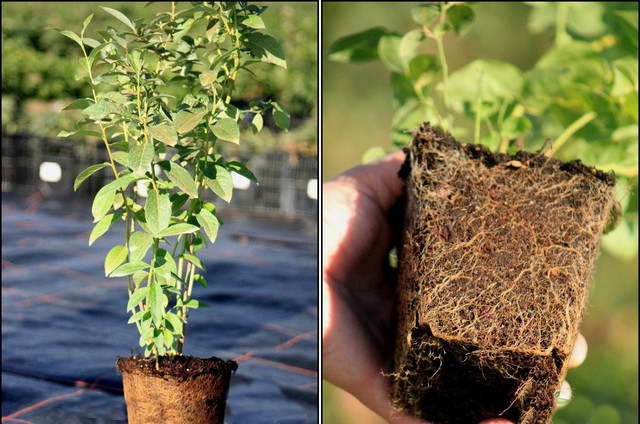

It is better to transplant adult bushes in the fall, after leaf fall. A planting pit or trench is prepared in advance, filled with a prepared substrate so that the soil has time to settle.
Soil preparation
Well-drained, light, peaty-sandy, loamy soils are favorable for the berry. The acidity of the substrate is from 3.5 to 4.8 units. All heather crops grow well only on acidic soils, a neutral, and even more so an alkaline environment is unfavorable for plants. This feature is due to the fact that the fibrous root of the plant functions in symbiosis with the fungal mycelium.
Important! Mycorrhiza is a form of symbiosis of plants with fungi, in which there is an interchange of nutrients. Fungal mycelium actively develops only in an acidic environment.
The soil mixture is prepared from:
- peat;
- sand;
- sawdust;
- fallen leaves, needles;
- tree bark.
The components are mixed by adding 40-60 g of sulfur.
Also, a solution of citric, acetic, malic acid helps to bring the acidity of the soil to 3.5-4.5 units. A cheaper option is battery electrolyte, 5 ml of which is diluted in 1 liter of water. The preparation of the pit will require 1.5-2 buckets of solution.


Planting in spring
A place for blueberries is selected sunny, on a hill, it is desirable that the land in this place be fallow for several years. In addition to lighting, the level of groundwater should be taken into account. In areas where flooding and stagnation of water are possible, drainage is mandatory. The feeding area for tall varieties should be 1.5-2 sq. m. When planting several plants, planting holes are dug at a distance of 1.2-1.5 m from each other, with a diameter of 60 cm and a depth of 40-50 cm. The bottom is lined with a thick layer of rotted leaves, prepared soil is laid on top.
How to care for blueberries in the fall
When planting berries in the fall, caring for bushes before winter takes less time than spring and summer care. During this period, you need to take care of the correct watering and feeding of the plant.
The top layer of the soil during the adaptation period should be moderately moist. The amount of moisture consumed directly depends on the autumn weather. During rainy and cloudy days, additional watering of the soil should not be done so as not to overmoisten the roots.
Dry weather requires weekly watering, about 10 liters of water for each bush planted.
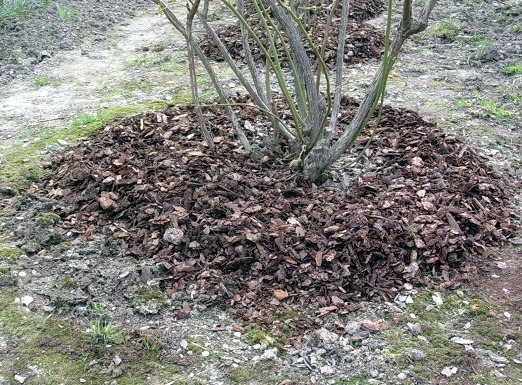

In autumn, potassium sulfate or potassium nitrate is added to the soil. Liquid solutions are not suitable for fertilization. The complexes are applied with dry granules and dug up with the soil.In autumn, it is not advised to fertilize blueberries with nitrogen-containing mixtures, they are suitable for spring feeding.
In addition, an important agricultural technique when caring for blueberries in the fall is the complete pruning of the planted bushes:
- weak and damaged branches are cut out completely;
- cut strong and healthy branches in half.
Diseases
The most common and similar in appearance is stem cancer and drying out of branches. Also, blueberries are affected by such a common disease as gray rot. To combat fungal diseases, three times spraying of plants is used before and after flowering with a 0.2% solution of topsin or euparen. All damaged branches must be cut and burned in a timely manner.
Diseases of a mycoplasma or viral nature pose a great danger to varietal blueberries. These include red and necrotic spotting, dwarfism, mosaic. Such diseases are extremely rare, but when they are diagnosed, the plants must be destroyed.
Preventive means of combating pathogens that cause blueberry disease are elementary agricultural techniques. Thanks to regular weeding, mulching of the soil, timely watering and feeding, the plant will fully develop and be able to resist diseases.
How to hide blueberries for the winter
In winter, blueberries are protected from freezing. Hybrid varieties that are made for sub-freezing regions are also covered to avoid loss of garden blueberry bushes.
Preparation for winter begins in the fall after disembarkation and includes several successive stages:
- Watering. Pre-winter watering of blueberries is abundant. It activates the spring budding. Abundant autumn watering is the entire amount of moisture that will feed the shrub in winter.
- Mulch. If, after planting, the soil was not mulched, then this must be done in preparation for winter. Mulch fulfills the duty of keeping heat and moisture for the soil. Taking into account the peculiarity of the development of the blueberry root system, mulch also helps to keep the roots from freezing.
- Soil acidification. If, after planting, there is a suspicion of a decrease in soil acidity, then it is additionally acidified in warm autumn. With the onset of a rainy and cold early autumn, acidification is shifted to the spring.
- Pruning. The blueberry bush is pruned in the fall without regrets. In spring, thawed branches will begin to grow actively, and in winter they will not be able to freeze with correct and timely pruning.
For winter shelter, burlap or agrofibre is used. The material of the additional shelter should be dense, but air-permeable, so that rotting does not begin inside the shelter.
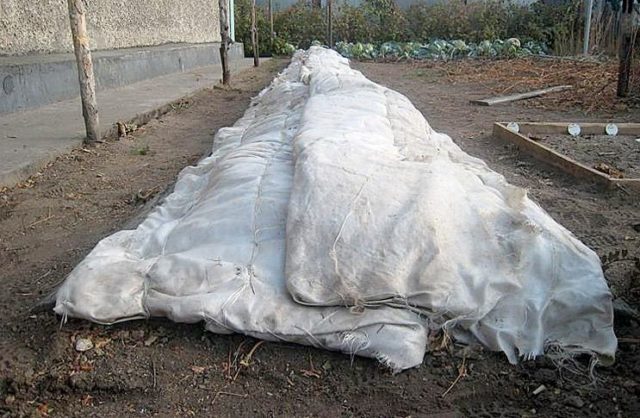

The cut bushes are wrapped in material, tied with nylon threads and secured with additional oppression.
Adult bushes begin to bend to the ground in advance so that the branches bend well and do not break after strapping. When the branches lie freely on the ground, they are covered, tied up and additional holders are laid. Small heavy boards, bricks are suitable for this.
When snow falls, collected snowdrifts are additionally applied to the covered bushes. They will become a natural protective layer against freezing. This completes the care of blueberries in winter.
In the spring, snow is removed before it melts. Then they begin to remove additional shelters so that the shrub does not become covered with condensation at freezing temperatures.


What mistakes gardeners often make when hiding blueberries for winter
Novice and experienced gardeners are not immune to common mistakes when growing a berry crop. Many people wonder when it is better to plant blueberries: in spring or autumn, what to do when planting in autumn, whether the bush will have time to adapt before frost. A mistake is the statement of novice gardeners: "If we plant blueberries in the fall, then they do not require any maintenance."This is a common misconception.
Typical mistakes that can be encountered on the path of growing blueberries:
- Excess moisture. Abundant pre-winter watering should not bring the soil to a swampy state. If the water does not have time to absorb before the temperature drops, then in winter the blueberry bush will freeze.
- Excess acid. With autumn acidification of the soil, an increased acid content leads to an increase in soil acidity. This negatively affects wintering and harms the further development of the bush.
- Loosening. The pre-winter loosening should not be deeper than 3 cm. Deeper digging of the soil can harm the root system, which is located close to the surface of the crop.



